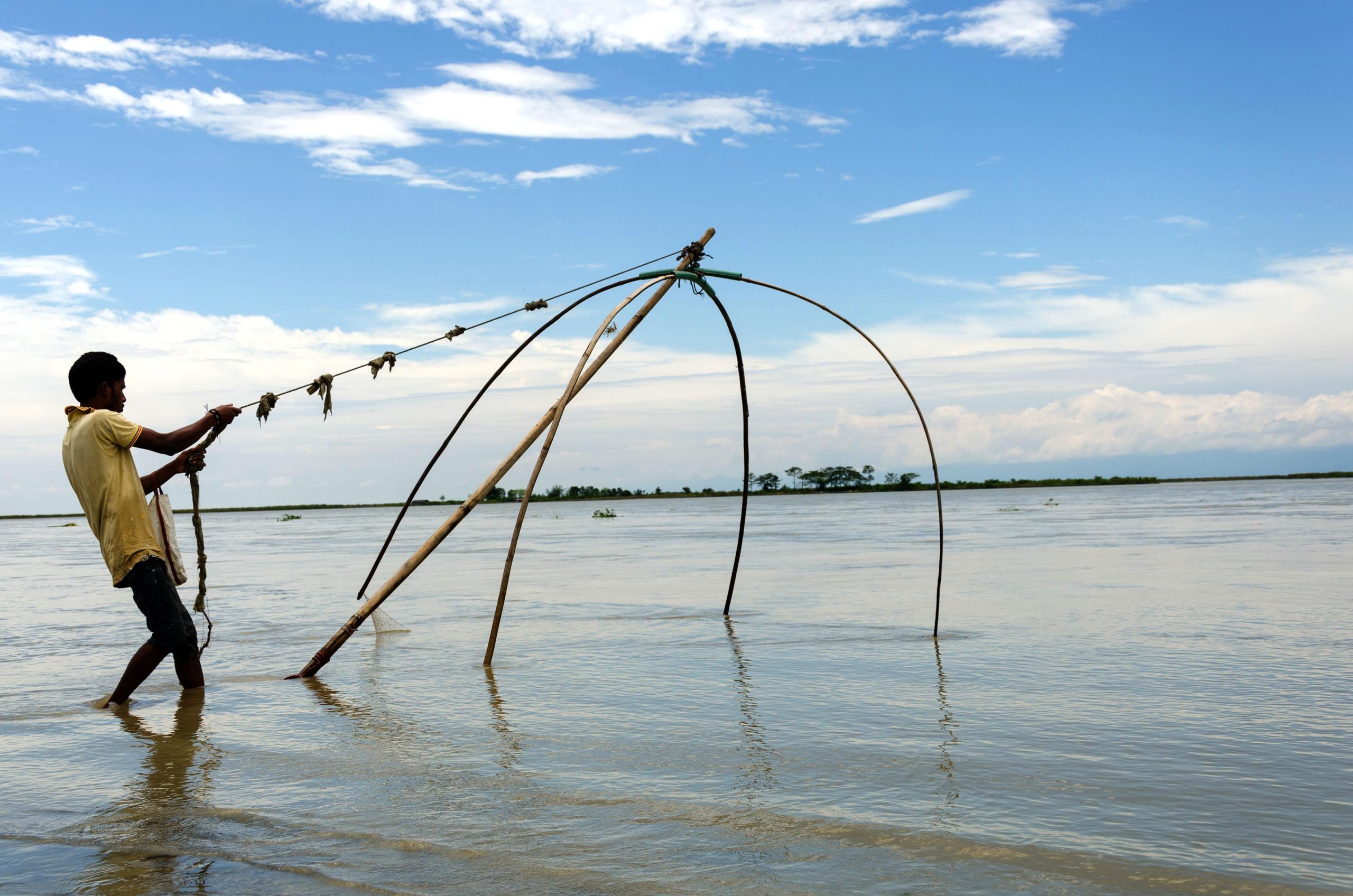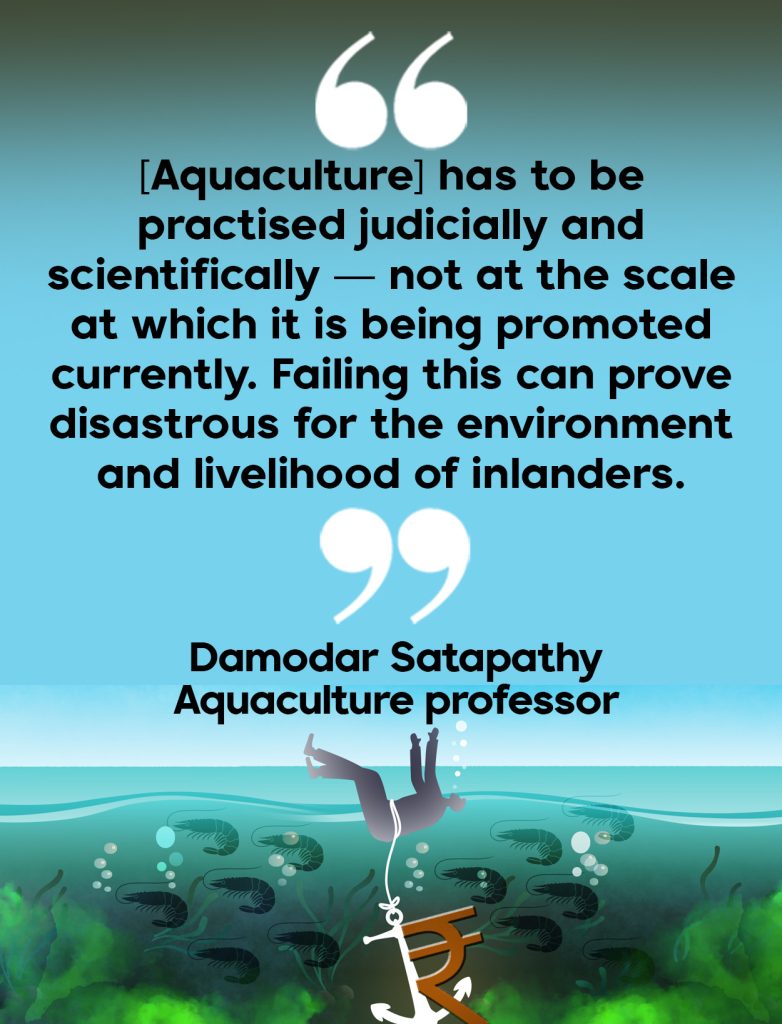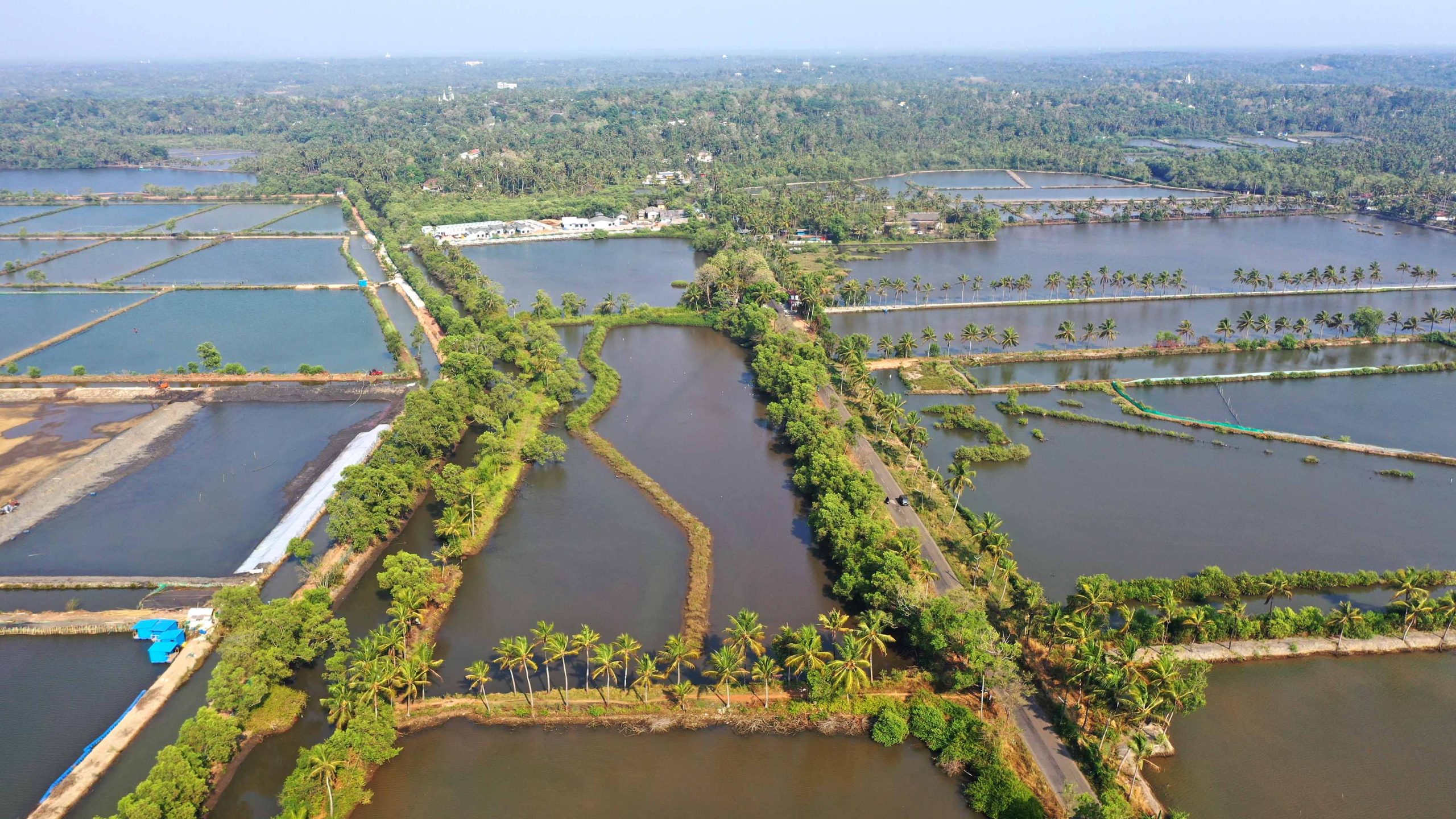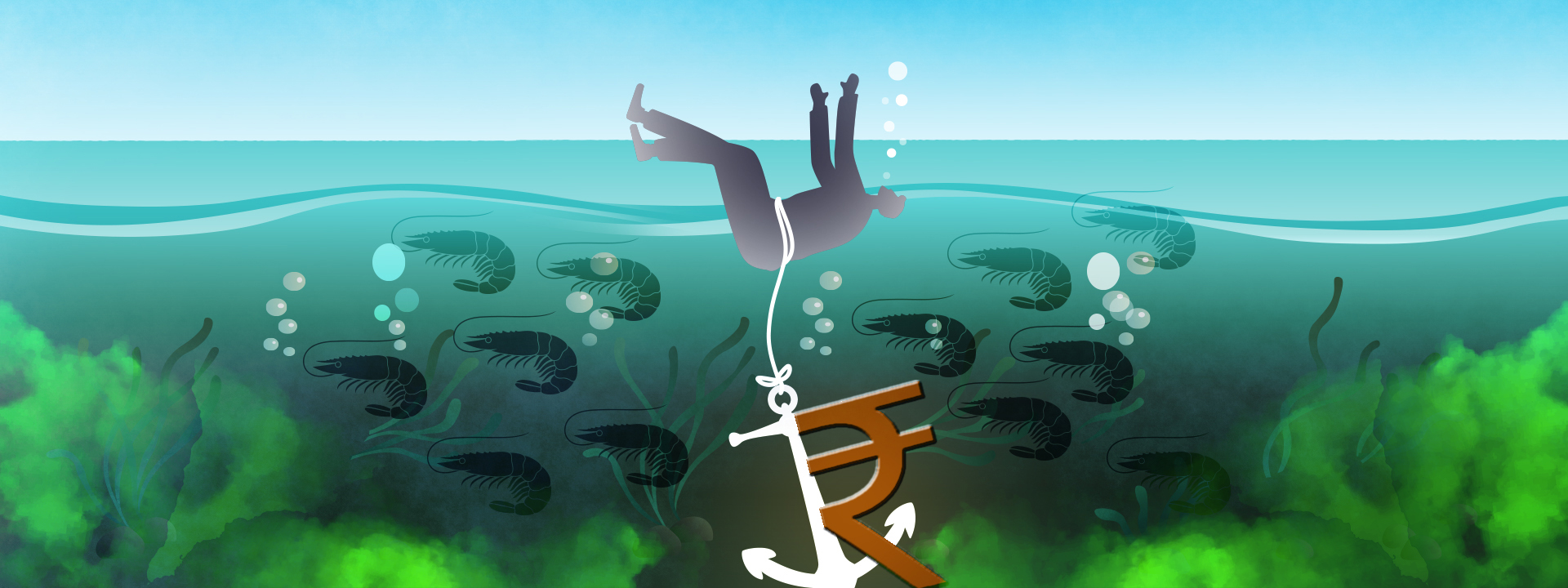|
Getting your Trinity Audio player ready...
|
W
en the going was good, Sujeet (not his real name) was making money hand over fist, with his relatives even sharing in some of the profits from his shrimp farm in the Indian state of West Bengal. But then the supercyclone Amphan hit eastern India and Bangladesh in May 2020, leaving destruction in its wake.
Sujeet’s shrimp farm – and those of many others in West Bengal and Odisha – was destroyed. In fact, about 10 percent of the 1,093 families in his village alone suffered a similar plight. Recalls Sujeet:“The entire farmed produce escaped during the cyclone with saline water entering the farm.”

“I could recover three lakhs (INR 300,000 or US$3,700),” says the 31-year-old, “but incurred a massive loss of 22 lakhs (INR 2.2 million or US$27,000).”
Unable to pay his outstanding debts and with no money to rebuild his shrimp farm, Sujeet left his family and fled more than 1,500 kms away to Gurugram, Haryana in northern India. He is still there, working as a housekeeping staff. He hopes to someday return to his village, but he is silent about whether he will ever return to shrimp farming.
Sujeet was actually practising commercial aquaculture, which has boomed in India in the last decade. Traditional aquaculture has been practised in India and many other countries across Asia for centuries. That, however, is mainly for household consumption and income generation for the family. Commercial aquaculture, in contrast, is aimed at maximizing profit, usually by maximizing production. In India, commercial aquaculture operators often have arrangements with major corporations, which provide them with feeds, fertilizers, and pesticides on loan while guaranteeing purchase of their goods.
Studies have shown that aquaculture is the most rapidly growing food-producing sector in the world. Globally, India is second only to China in aquaculture production, devoting much of it to farming shrimp. West Bengal meanwhile is the second largest aquaculture producer in India (after Andhra Pradesh), with districts of South and North 24 Parganas – where Sujeet’s home village is located – dominating the major share of such products in the state.
But the race for ever-increasing profit has apparently led to a wanton disregard of rules and laws meant to keep the practice sustainable and ecologically friendly. As a result, lives have been upended in areas where there has been rampant conversion of agricultural land into aquaculture ventures. Such farming has wrought environmental havoc as well; in West Bengal, the damage has reached even the Sundarbans Biosphere Reserve (SBR), a UNESCO World Heritage Site and the largest deltaic mangrove zone on the planet.
“Commercial aquaculture is harmful to the environment,” says Damodar Satapathy, a professor in aquaculture. “It is input-intensive, requiring large quantities of feed, seed and fertilizer. The input overloading in the expectation of high yield is a problem. There are other issues like waste generation and degradation of soil and the environment because of drug use. The farmers often forgo efficient waste-management procedures. Leaching of antibiotics and other pollutants from aquafarms into the environment is another issue leading to the destruction of mangroves.”
The lure of big money
According to Satapathy, commercial aquaculture is highly dependent on the palate feed with high nitrogen content, leading to high biological oxygen demand (BOD) in the water. Other commercial activities that take place around aquaculture, like the movement of large ships, further pollute the water bodies.
Amitabha Sarkar, a researcher with Global Health Centre, Graduate Institute of International and Development Studies in Geneva, says that land degradation is rampant in aquaculture. In the absence of safeguards, such degradation covers adjoining areas. Not surprisingly, when the pollutants enter nearby farms and water bodies, tensions rise within the community. Aquaculture is not labor-intensive as compared to agriculture, so there is loss of employment as well.
Sources: Fish Welfare Initiative, Asian Development Bank, Aquaculture Asia, Environmental Analysis, Health and Toxicology, Asia-Pacific Journal of Regional Science, International Labour Organization
Yet it’s not hard to see why people have taken up commercial aquaculture. According to a study published in February 2022 by the Asia Pacific Journal of Regional Science, a shrimp farmer can have a net profit that is three times larger than the average profit from traditional agriculture in just one harvest season.
“Many people around our village invested in aquaculture,” says Sujeet. “I worked in other cities and saved. The profits were attractive, so we put money. The depot provides us with seeds, feeds, and fertilizers on credit. I bought inputs worth eight lakhs (INR 800,000 or US$9,756) on credit and invested two lakhs (INR 200,000 or US$2,440) from my savings. Since there were no cyclones after (Cyclone) Alia in 2009, we didn’t foresee any threat. In the first year, the profit was substantial. This encouraged me to plough the money into a bigger pond.”
For sure, though, many socioeconomic and — ironically enough — environmental factors have contributed to the rapid growth of commercial aquaculture in India. In a 2022 commentary on aquafarming in SBR, researcher Shaberi Das and oceanographic studies professor Sugata Hazra wrote: “In the last few decades, erratic monsoons alongside the temperature rise on land and sea, frequent cyclones and floods, and the increasing cost of fertilizers and farming have reduced agricultural productivity and driven more and more farmers to adapt by shifting to inland aquaculture.”
“The Bay of Bengal has seen an increase in the number of storms,” says Amitabha Sarkar. “With cyclones, the vast cultivable land gets flooded with saline coastal water, making it unfit for agriculture.”
“Agriculture is not predictable,” comments a migrant from the Sundarbans who is now in Gurugram. “Not just cyclones, thunderstorms and heavy rainfall disrupt the agricultural activities.” Declining marine resources and energy crises have made aquaculture an attractive alternative as well.
Ignoring problems
Yet aquaculture itself is not without its own pitfalls. Sarkar points out that like agricultural products, aquaculture produce is also subject to price fluctuations. And as Sujeet’s experience shows, weather disturbances can pose problems for aquafarmers as well.

There are other challenges. Satapathy notes that one needs to monitor the farm produce from time to time. It is susceptible to infection. If the disease spreads, the entire farm produce can vanish within a few hours. In addition, aquaculture operations may have to cope with the changed disease and pest risks in the future because of climate change.
“One should make farmers aware of risks related to aquaculture,” Satapathy says. “Shifts in tidal patterns and salinity can have implications for aquaculture in this region.”
He rues the unregulated growth of commercial aquaculture. Points out Satapathy: “One must follow protocols before sanctioning a project. For instance, there are site selection benchmarks. As per the government of India, one needs site clearance. While studying the feasibility, one must consider social and ecological impacts. We undervalue these crucial facets because of greed.“
This is despite the existence of laws to limit problems arising from commercial aquaculture. Noted Das and Hazra in their article published by the environmental online publication Mongabay: “Several laws such as the West Bengal Land Reforms Act, 1955, West Bengal Inland Fisheries (Amendment) Act, 1993, and the Coastal Aquaculture Authority Act, 2005, have outlawed the conversion of agricultural and forest land for aquaculture in the coastal areas. How then does the expansion of aquaculture at the expense of sustainable development and conservation continue unabated?”
“The answer,” they wrote, “lies in the government’s tacit support and significant political and commercial clout in commercial aquaculture. Lukewarm enforcement of existing laws becomes the most potent instrument for promoting profitability at the cost of the environment and the well-being of the local communities.”
In the meantime, Sarkar remarks that once agricultural land is converted into aquaculture farms, it is irreversible. This has implications for food security.
“We can see aquaculture as a viable option in the face of failing agriculture,” Satapathy says. “However, government intervention and monitoring are important. It has to be practised judicially and scientifically — not at the scale at which it is being promoted currently. Failing this can prove disastrous for the environment and livelihood of inlanders.”
In September 2020, the central government launched the Pradhan Mantri Matsya Sampada Yojana (Prime Minister Fishery Wealth Scheme or PMMSY) to promote traditional aquaculture. Satapathy thinks it is promising and may yet help lead to market regulation. But it came too late for Sujeet and his fellow villager-aquafarmers. By the time it was introduced, they had already lost their shrimp farms to Amphan.

Three other villagers had fled with Sujeet to Gurugram; others opted to escape their creditors by heading to larger towns in the south of the country. One of Sujeet’s fellow villagers took his own life in desperation. Sujeet says that he doesn’t want a similar end.◉

























